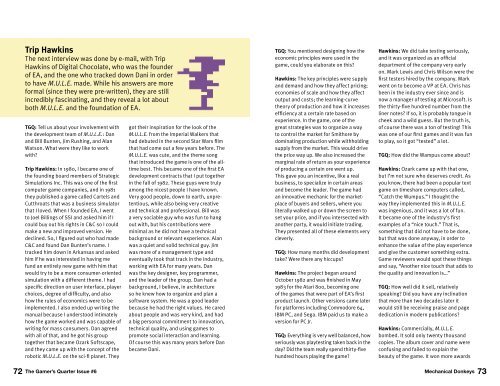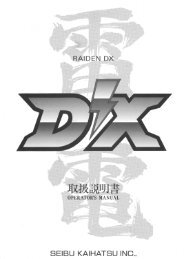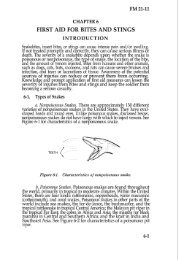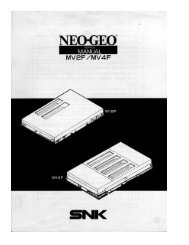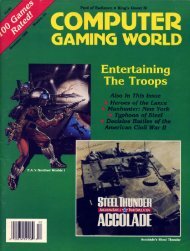The Gamer's Quarter - Issue #6 - TextFiles.com
The Gamer's Quarter - Issue #6 - TextFiles.com
The Gamer's Quarter - Issue #6 - TextFiles.com
You also want an ePaper? Increase the reach of your titles
YUMPU automatically turns print PDFs into web optimized ePapers that Google loves.
Trip Hawkins<br />
<strong>The</strong> next interview was done by e-mail, with Trip<br />
Hawkins of Digital Chocolate, who was the founder<br />
of EA, and the one who tracked down Dani in order<br />
to have M.U.L.E. made. While his answers are more<br />
formal (since they were pre-written), they are still<br />
incredibly fascinating, and they reveal a lot about<br />
both M.U.L.E. and the foundation of EA.<br />
TGQ: Tell us about your involvement with<br />
the development team of M.U.L.E.: Dan<br />
and Bill Bunten, Jim Rushing, and Alan<br />
Watson. What were they like to work<br />
with?<br />
Trip Hawkins: In 1980, I became one of<br />
the founding board members of Strategic<br />
Simulations Inc. This was one of the fi rst<br />
<strong>com</strong>puter game <strong>com</strong>panies, and in 1981<br />
they published a game called Cartels and<br />
Cutthroats that was a business simulator<br />
that I loved. When I founded EA, I went<br />
to Joel Billings of SSI and asked him if I<br />
could buy out his rights in C&C so I could<br />
make a new and improved version. He<br />
declined. So, I fi gured out who had made<br />
C&C and found Dan Bunten’s name. I<br />
tracked him down in Arkansas and asked<br />
him if he was interested in having me<br />
fund an entirely new game with him that<br />
would try to be a more consumer-oriented<br />
simulation with a different theme. I had<br />
specifi c direction on user interface, player<br />
choices, degree of diffi culty, and also<br />
how the rules of economics were to be<br />
implemented. I also ended up writing the<br />
manual because I understood intimately<br />
how the game worked and was capable of<br />
writing for mass consumers. Dan agreed<br />
with all of that, and he got his group<br />
together that became Ozark Softscape,<br />
and they came up with the concept of the<br />
robotic M.U.L.E. on the sci-fi planet. <strong>The</strong>y<br />
got their inspiration for the look of the<br />
M.U.L.E. from the Imperial Walkers that<br />
had debuted in the second Star Wars fi lm<br />
that had <strong>com</strong>e out a few years before. <strong>The</strong><br />
M.U.L.E. was cute, and the theme song<br />
that introduced the game is one of the alltime<br />
best. This became one of the fi rst EA<br />
development contracts that I put together<br />
in the fall of 1982. <strong>The</strong>se guys were truly<br />
among the nicest people I have known.<br />
Very good people, down to earth, unpretentious,<br />
while also being very creative<br />
and technical and professional. Bill was<br />
a very sociable guy who was fun to hang<br />
out with, but his contributions were<br />
minimal as he did not have a technical<br />
background or relevant experience. Alan<br />
was a quiet and solid technical guy. Jim<br />
was more of a management type and<br />
eventually took that track in the industry,<br />
working with EA for many years. Dan<br />
was the key designer, key programmer,<br />
and the leader of the group. Dan had a<br />
background, I believe, in architecture<br />
so he knew how to organize and plan a<br />
software system. He was a good leader<br />
because he had the right values. He cared<br />
about people and was very kind, and had<br />
a big personal <strong>com</strong>mitment to innovation,<br />
technical quality, and using games to<br />
promote social interaction and learning.<br />
Of course this was many years before Dan<br />
became Dani.<br />
TGQ: You mentioned designing how the<br />
economic principles were used in the<br />
game, could you elaborate on this?<br />
Hawkins: <strong>The</strong> key principles were supply<br />
and demand and how they affect pricing;<br />
economies of scale and how they affect<br />
output and costs; the learning-curve<br />
theory of production and how it increases<br />
effi ciency at a certain rate based on<br />
experience. In the game, one of the<br />
great strategies was to organize a way<br />
to control the market for Smithore by<br />
dominating production while withholding<br />
supply from the market. This would drive<br />
the price way up. We also increased the<br />
marginal rate of return as your experience<br />
of producing a certain ore went up.<br />
This gave you an incentive, like a real<br />
business, to specialize in certain areas<br />
and be<strong>com</strong>e the leader. <strong>The</strong> game had<br />
an innovative mechanic for the marketplace<br />
of buyers and sellers, where you<br />
literally walked up or down the screen to<br />
set your price, and if you intersected with<br />
another party, it would initiate trading.<br />
<strong>The</strong>y presented all of these elements very<br />
cleverly.<br />
TGQ: How many months did development<br />
take? Were there any hiccups?<br />
Hawkins: <strong>The</strong> project began around<br />
October 1982 and was fi nished in May<br />
1983 for the Atari 800, be<strong>com</strong>ing one<br />
of the games that were part of EA’s fi rst<br />
product launch. Other versions came later<br />
for platforms including Commodore 64,<br />
IBM PC, and Sega. IBM paid us to make a<br />
version for PC Jr.<br />
TGQ: Everything is very well balanced, how<br />
seriously was playtesting taken back in the<br />
day? Did the team really spend thirty-fi ve<br />
hundred hours playing the game?<br />
Hawkins: We did take testing seriously,<br />
and it was organized as an offi cial<br />
department of the <strong>com</strong>pany very early<br />
on. Mark Lewis and Chris Wilson were the<br />
fi rst testers hired by the <strong>com</strong>pany. Mark<br />
went on to be<strong>com</strong>e a VP at EA. Chris has<br />
been in the industry ever since and is<br />
now a manager of testing at Microsoft. Is<br />
the thirty-fi ve hundred number from the<br />
liner notes? If so, it is probably tongue in<br />
cheek and a wild guess. But the truth is,<br />
of course there was a ton of testing! This<br />
was one of our fi rst games and it was fun<br />
to play, so it got “tested” a lot.<br />
TGQ: How did the Wampus <strong>com</strong>e about?<br />
Hawkins: Ozark came up with that one,<br />
but I’m not sure who deserves credit. As<br />
you know, there had been a popular text<br />
game on timeshare <strong>com</strong>puters called,<br />
“Catch the Wumpus.” I thought the<br />
way they implemented this in M.U.L.E.<br />
was ingenious, and it was a lot of fun.<br />
It became one of the industry’s fi rst<br />
examples of a “nice touch.” That is,<br />
something that did not have to be done,<br />
but that was done anyway, in order to<br />
enhance the value of the play experience<br />
and give the customer something extra.<br />
Game reviewers would spot these things<br />
and say, “Another nice touch that adds to<br />
the quality and innovation is…”<br />
TGQ: How well did it sell, relatively<br />
speaking? Did you have any inclination<br />
that more than two decades later it<br />
would still be receiving praise and page<br />
dedication in modern publications?<br />
Hawkins: Commercially, M.U.L.E.<br />
bombed. It sold only twenty thousand<br />
copies. <strong>The</strong> album cover and name were<br />
confusing and failed to explain the<br />
beauty of the game. It won more awards<br />
72 <strong>The</strong> Gamer’s <strong>Quarter</strong> <strong>Issue</strong> <strong>#6</strong><br />
Mechanical Donkeys<br />
73


